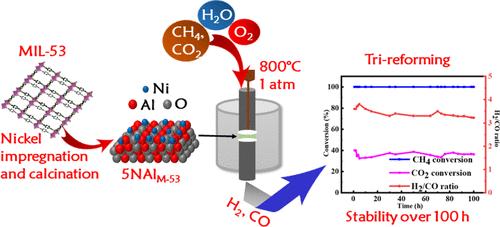Metal–Organic Framework-Templated Synthesis of Nickel–Alumina Nanocatalysts Improves Catalyst–Support Interaction for Higher Activity and Stability in Biogas Reforming under Controlled Oxidizing Conditions
IF 8.3
2区 材料科学
Q1 MATERIALS SCIENCE, MULTIDISCIPLINARY
引用次数: 0
Abstract
Tri-reforming methane with CO2, O2, and H2O mixtures requires a delicate balance of dry-reforming, partial oxidation, and steam-reforming reactions to improve the CO2 conversion and H2/CO ratio. Nickel–alumina has been reported before for the tri-reforming of methane, although at higher temperatures (>900 °C). This is because the current approaches for nickel–alumina synthesis are ineffective in generating stronger catalyst–support interactions necessary to maintain higher active sites and stall carbon nanotube (CNT) deposition. Here, we report a synthesis method that allows controlled loading of nickel on alumina-based MIL-53 metal–organic framework followed by calcination to generate 2.5–10 wt % nickel nanoparticles dispersed on alumina. The 5 wt % nickel–alumina mixtures resulted in nanometer-sized crystallites, better metal dispersion, and more active sites for enhanced catalytic activity. This optimal loading of nickel allows stronger interaction with alumina for over 100 h of stable performance of tri-reforming at 800 °C, achieving ∼98% CH4 conversion, ∼36% CO2 conversion, and no carbon deposition while producing Fischer–Tropsch-ready feed containing a H2/CO ratio of 3.2.

金属有机框架催化合成的镍铝纳米催化剂改善了催化剂与支撑物之间的相互作用,从而提高了沼气在可控氧化条件下转化的活性和稳定性
用 CO2、O2 和 H2O 混合物对甲烷进行三重转化需要在干转化、部分氧化和蒸汽转化反应之间取得微妙的平衡,以提高 CO2 转化率和 H2/CO 比率。以前曾有报道称镍氧化铝可用于甲烷的三重转化,但温度较高(900 °C)。这是因为目前的镍-氧化铝合成方法无法产生维持更高活性位点和阻止碳纳米管(CNT)沉积所需的更强催化剂-支撑相互作用。在此,我们报告了一种合成方法,该方法可以在氧化铝基 MIL-53 金属有机框架上控制镍的负载,然后通过煅烧生成 2.5-10 wt % 的镍纳米颗粒,分散在氧化铝上。5 wt % 的镍-氧化铝混合物可产生纳米尺寸的晶体、更好的金属分散性和更多的活性位点,从而提高催化活性。这种最佳的镍负载量使镍与氧化铝的相互作用更强,从而在 800 °C 下稳定地进行了 100 多小时的三重转化,实现了 ∼98% 的 CH4 转化率、∼36% 的 CO2 转化率和无碳沉积,同时生产出了含 H2/CO 比率为 3.2 的费托原料。
本文章由计算机程序翻译,如有差异,请以英文原文为准。
求助全文
约1分钟内获得全文
求助全文
来源期刊

ACS Applied Materials & Interfaces
工程技术-材料科学:综合
CiteScore
16.00
自引率
6.30%
发文量
4978
审稿时长
1.8 months
期刊介绍:
ACS Applied Materials & Interfaces is a leading interdisciplinary journal that brings together chemists, engineers, physicists, and biologists to explore the development and utilization of newly-discovered materials and interfacial processes for specific applications. Our journal has experienced remarkable growth since its establishment in 2009, both in terms of the number of articles published and the impact of the research showcased. We are proud to foster a truly global community, with the majority of published articles originating from outside the United States, reflecting the rapid growth of applied research worldwide.
 求助内容:
求助内容: 应助结果提醒方式:
应助结果提醒方式:


